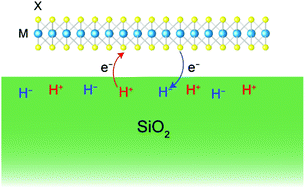An origin of unintentional doping in transition metal dichalcogenides: the role of hydrogen impurities†
Abstract
We theoretically elucidate the origin of unintentional doping in two-dimensional transition-metal dichalcogenides (TMDs), which has been consistently reported by experiment, but which still remains unclear. Our explanation is based on the charge transfer between TMDs and the underlying SiO2 in which hydrogen impurities with a negative-U property pin the Fermi level of the SiO2 as well as adjacent TMD layers. Using first-principles calculations, we obtain the pinning point of the Fermi level from the charge transition level of the hydrogen in the SiO2, ε(+/−), and align it with respect to the band-edge positions of monolayer TMDs. The computational results show that the Fermi levels of TMDs estimated by ε(+/−) successfully explain the conducting polarity (n- or p-type) and relative doping concentrations of thin TMD films. By enlightening on the microscopic origin of unintentional doping in TMDs, we believe that the present work will contribute to precise control of TMD-based electronic devices.



 Please wait while we load your content...
Please wait while we load your content...